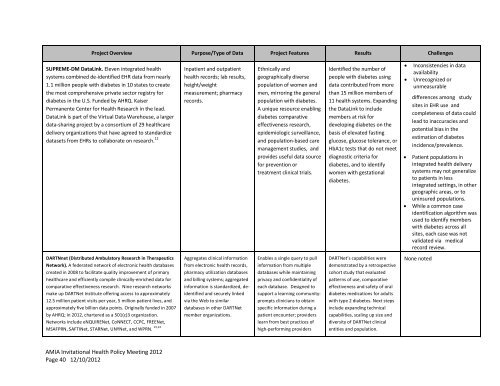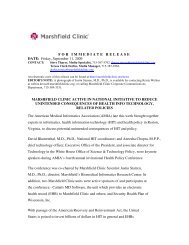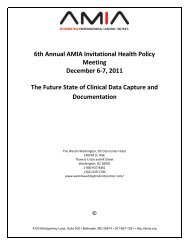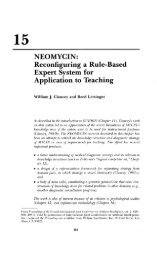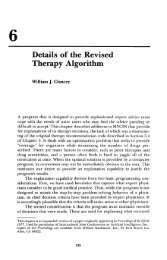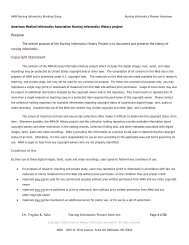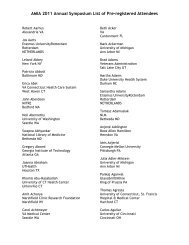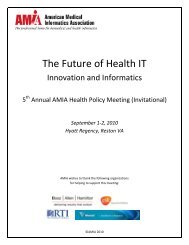7th Annual AMIA Invitational Health Policy Meeting December 12-13 ...
7th Annual AMIA Invitational Health Policy Meeting December 12-13 ...
7th Annual AMIA Invitational Health Policy Meeting December 12-13 ...
Create successful ePaper yourself
Turn your PDF publications into a flip-book with our unique Google optimized e-Paper software.
Project Overview Purpose/Type of Data Project Features Results Challenges<br />
SUPREME-DM DataLink. Eleven integrated health<br />
systems combined de-identified EHR data from nearly<br />
1.1 million people with diabetes in 10 states to create<br />
the most comprehensive private sector registry for<br />
diabetes in the U.S. Funded by AHRQ. Kaiser<br />
Permanente Center for <strong>Health</strong> Research in the lead.<br />
DataLink is part of the Virtual Data Warehouse, a larger<br />
data-sharing project by a consortium of 29 healthcare<br />
delivery organizations that have agreed to standardize<br />
datasets from EHRs to collaborate on research. <strong>12</strong><br />
DARTNnet (Distributed Ambulatory Research in Therapeutics<br />
Network). A federated network of electronic health databases<br />
created in 2008 to facilitate quality improvement of primary<br />
healthcare and efficiently compile clinically-enriched data for<br />
comparative effectiveness research. Nine research networks<br />
make up DARTNet Institute offering access to approximately<br />
<strong>12</strong>.5 million patient visits per year, 5 million patient lives, and<br />
approximately five billion data points. Originally funded in 2007<br />
by AHRQ; in 20<strong>12</strong>, chartered as a 501(c)3 organization.<br />
Networks include eNQUIRENet, CoNNECT, CCPC, FREENet,<br />
MSAFPRN, SAFTINet, STARNet, UNYNet, and WPRN. <strong>13</strong>,14<br />
<strong>AMIA</strong> <strong>Invitational</strong> <strong>Health</strong> <strong>Policy</strong> <strong>Meeting</strong> 20<strong>12</strong><br />
Page 40 <strong>12</strong>/10/20<strong>12</strong><br />
Inpatient and outpatient<br />
health records; lab results,<br />
height/weight<br />
measurement; pharmacy<br />
records.<br />
Aggregates clinical information<br />
from electronic health records,<br />
pharmacy utilization databases<br />
and billing systems; aggregated<br />
information is standardized, deidentified<br />
and securely linked<br />
via the Web to similar<br />
databases in other DARTNet<br />
member organizations.<br />
Ethnically and<br />
geographically diverse<br />
population of women and<br />
men, mirroring the general<br />
population with diabetes.<br />
A unique resource enabling<br />
diabetes comparative<br />
effectiveness research,<br />
epidemiologic surveillance,<br />
and population-based care<br />
management studies, and<br />
provides useful data source<br />
for prevention or<br />
treatment clinical trials.<br />
Enables a single query to pull<br />
information from multiple<br />
databases while maintaining<br />
privacy and confidentiality of<br />
each database. Designed to<br />
support a learning community:<br />
prompts clinicians to obtain<br />
specific information during a<br />
patient encounter; providers<br />
learn from best practices of<br />
high-performing providers<br />
Identified the number of<br />
people with diabetes using<br />
data contributed from more<br />
than 15 million members of<br />
11 health systems. Expanding<br />
the DataLink to include<br />
members at risk for<br />
developing diabetes on the<br />
basis of elevated fasting<br />
glucose, glucose tolerance, or<br />
HbA1c tests that do not meet<br />
diagnostic criteria for<br />
diabetes, and to identify<br />
women with gestational<br />
diabetes.<br />
DARTNet’s capabilities were<br />
demonstrated by a retrospective<br />
cohort study that evaluated<br />
patterns of use, comparative<br />
effectiveness and safety of oral<br />
diabetes medications for adults<br />
with type 2 diabetes. Next steps<br />
include expanding technical<br />
capabilities, scaling up size and<br />
diversity of DARTNet clinical<br />
entities and population.<br />
� Inconsistencies in data<br />
availability<br />
� Unrecognized or<br />
unmeasurable<br />
differences among study<br />
sites in EHR use and<br />
completeness of data could<br />
lead to inaccuracies and<br />
potential bias in the<br />
estimation of diabetes<br />
incidence/prevalence.<br />
� Patient populations in<br />
integrated health delivery<br />
systems may not generalize<br />
to patients in less<br />
integrated settings, in other<br />
geographic areas, or to<br />
uninsured populations.<br />
� While a common case<br />
identification algorithm was<br />
used to identify members<br />
with diabetes across all<br />
sites, each case was not<br />
validated via medical<br />
record review.<br />
None noted


